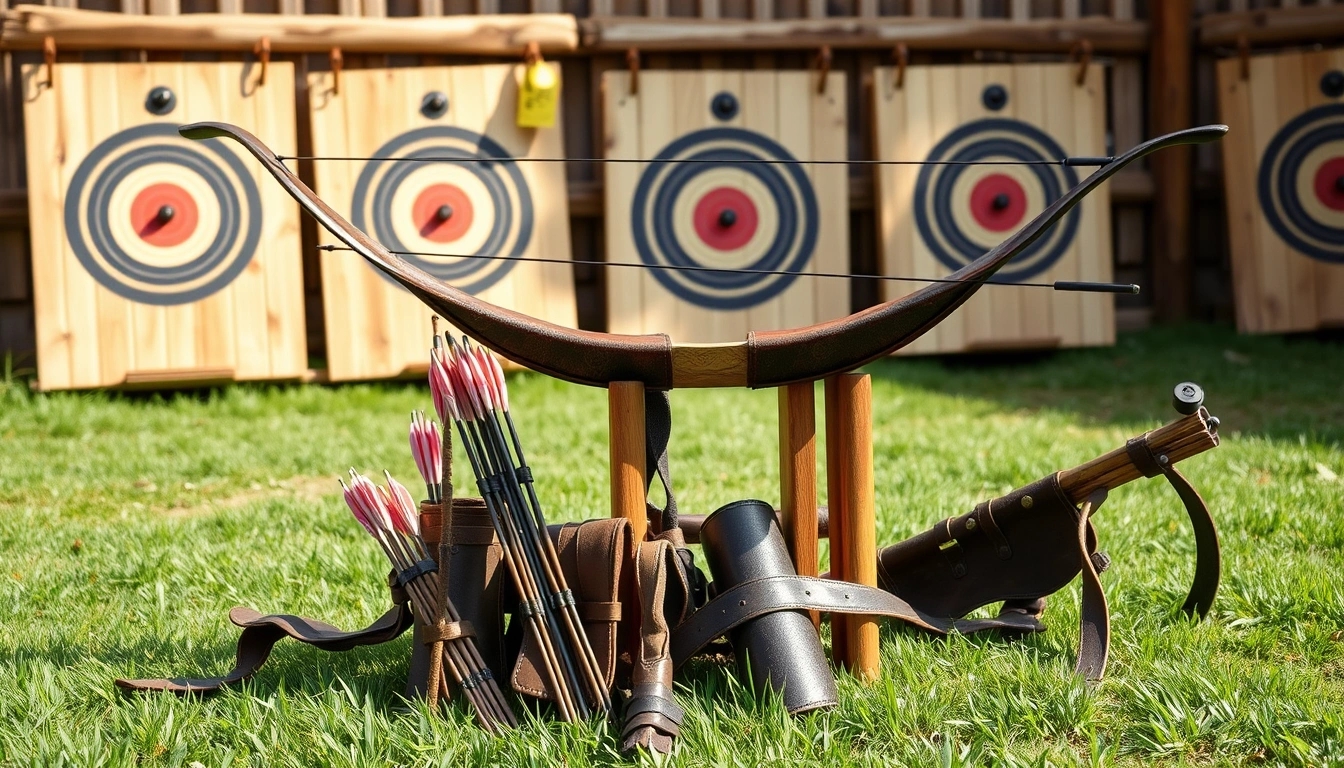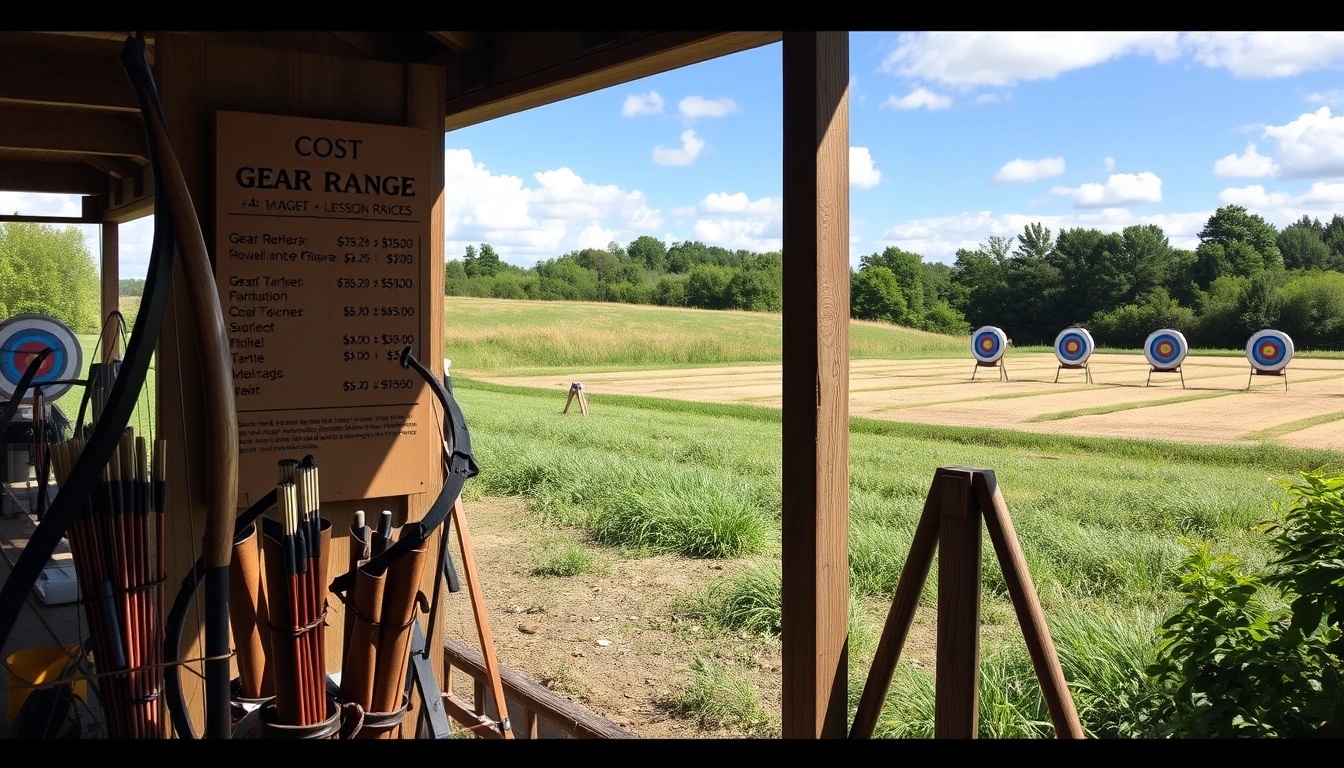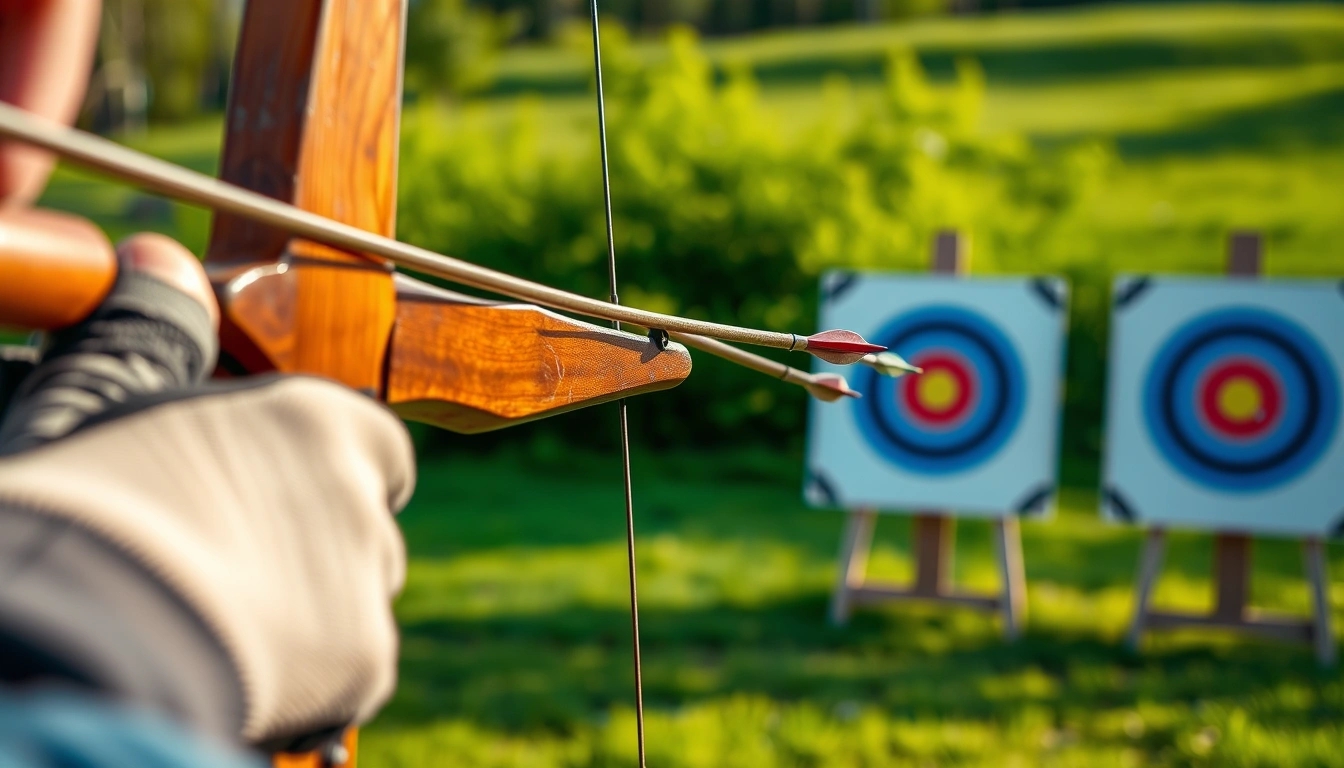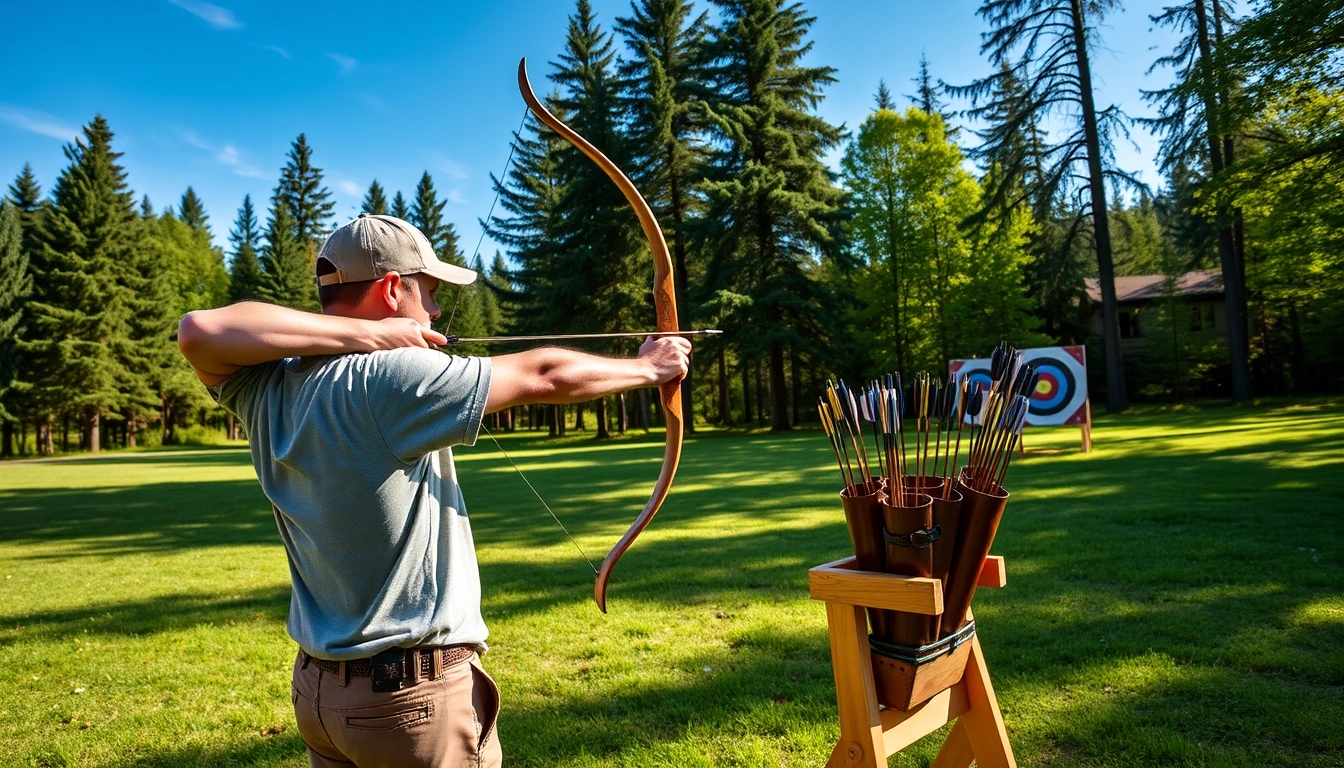Alright, so you’ve caught the archery bug and fancy yourself a bit of a Robin Hood or Katniss Everdeen, eh? Whether you’re a total newbie who thinks a bow is just a fancy hanger or a seasoned pro looking to sharpen your aim, the UK has got you covered with spots that’ll have you hitting bullseyes in no time—or at least not embarrassing yourself too much. Let’s dive into the best places and some handy tips for all skill levels, with a sprinkle of fun and a dash of reality thrown in.
- Top Archery Clubs Across the UK: From London’s bustling clubs like Archery GB to the scenic grounds of York Archers, there’s a spot for everyone. These clubs often welcome beginners with open arms and offer affordable memberships. Don’t expect luxury spas, but you’ll get plenty of camaraderie and a chance to geek out over gear.
- Beginner-Friendly Courses: If you’re the kind who likes a bit of hand-holding (or just hates looking clueless), courses like those at East Midlands Archery Academy are perfect. Expect to spend a few hours learning safety basics, stance, and how not to shoot your arrow into next week. Pro tip: wear comfy clothes and don’t forget your sense of humour.
Here’s a quick table to compare some popular clubs and courses:
| Club/Course | Location | Cost | Beginner Friendly | Indoor/Outdoor |
|---|---|---|---|---|
| Archery GB | London | £40/month | Yes | Both |
| York Archers | York | £30/month | Mixed | Outdoor |
| East Midlands Archery Academy | Nottingham | £50/course | Yes | Indoor |
Now, gear talk. You don’t need to splash out on the fanciest bow that looks like it belongs in a sci-fi movie. Beginners should focus on basics: a decent recurve bow, some arrows that fit you (length matters, trust me), and a finger tab or glove. Anything shiny beyond that? Mostly to impress your mates or intimidate your opponents. Keep it simple, keep it safe.
Indoor versus outdoor archery? Well, if you hate the unpredictable British weather (and who doesn’t?), indoor might be your jam. Controlled environment, no soggy shoes, and you can shoot year-round. But nothing beats the fresh air and challenge of outdoor shooting, especially when the sun decides to show up. Just remember to layer up and maybe bring a flask of tea.
- Finding a Coach: Don’t settle for someone who just shouts “pull!” Find a coach who’s patient, knows their stuff, and can make practice fun rather than a chore. Ask clubs for recommendations or check online reviews.
- Costs: Archery isn’t the cheapest hobby, but it’s not the most expensive either. Expect to pay for lessons, club fees, and gear upgrades. Hidden fees? Mostly for fancy arrows or custom fittings.
To wrap it up, getting into archery in the UK is a bit like learning to ride a bike—awkward at first, but once you get the hang of it, it’s addictive. So grab a bow, find a club, and don’t be surprised if your first dozen arrows look like a toddler’s scribbles. It happens to the best of us.
Top Archery Clubs Across the UK
Alright, if you’re itching to get your bow bending and arrows flying without emptying your wallet, you’ve landed in the right spot. The UK is peppered with archery clubs that cater to everyone—from absolute newbies who can barely hold a bow, to seasoned pros who’d make Robin Hood jealous. But here’s the kicker: not all clubs are created equal, and some will set you back a fortune, while others offer a proper bang for your buck.
First up, let’s talk about Archers’ Haven in London. It’s a bit of a hidden gem, honestly. They run beginner-friendly sessions, and their membership fees won’t make you weep. Plus, the vibe is super chill—no pressure, just good ol’ fun. You’ll find a mix of ages and skill levels, which is perfect if you want to learn from folks who’ve been around the block a few times.
Then there’s Yorkshire Bowmen, a club that’s been around since forever (well, since the 1950s) and has a reputation for being welcoming and well-organized. They’ve got both indoor and outdoor ranges, so you can practice rain or shine—because let’s face it, the British weather is about as predictable as a cat on espresso. The fees are reasonable too, and they throw in coaching sessions that actually help you improve instead of just waving a bow around.
| Club Name | Location | Membership Cost | Facilities | Beginner Friendly? |
|---|---|---|---|---|
| Archers’ Haven | London | £40/month | Indoor & Outdoor ranges | Yes |
| Yorkshire Bowmen | Yorkshire | £35/month | Indoor & Outdoor ranges, Coaching | Yes |
| Glasgow Archery Club | Glasgow | £30/month | Outdoor range | Moderate |
| South Coast Archers | Brighton | £45/month | Indoor range, Equipment hire | Yes |
Oh, and if you’re up north, Glasgow Archery Club is worth a look. It’s a bit more old-school, but the members are friendly enough to make you feel like family (the kind you actually like). The outdoor-only range means you’ll have to brave the elements, but hey, that’s part of the charm, right?
Down south, South Coast Archers in Brighton offer a swanky indoor range and even equipment hire, which is brilliant if you’re just testing the waters and not ready to splash out on your own bow and arrows. Their coaching is top-notch, and they cater well to beginners, so you won’t feel like a total plonker on your first try.
- Pro tip: Always check if the club offers trial sessions before committing. It’s a great way to suss out the atmosphere and see if you vibe with the crowd.
- Another thing: Some clubs have social events and competitions that are perfect for meeting fellow archers and sharpening your skills under a bit of friendly pressure.
To wrap it up, the UK’s archery scene is surprisingly vibrant and affordable if you know where to look. Whether you fancy a laid-back club with a community feel or somewhere more competitive, there’s something out there for you. Just remember, it’s not about how fancy the gear or the club is—it’s about getting out there, nocking that arrow, and having a laugh while you’re at it.
Beginner-Friendly Archery Courses
So, you’ve decided to give archery a whirl — maybe you’ve seen those slick shots in movies, or you just fancy trying something a bit different from your usual gym grind. Whatever the reason, starting out in archery can feel a bit like stepping into a whole new world. The good news? There are plenty of beginner-friendly courses designed just for folks who don’t know their bowstrings from their arrows yet. Let’s dive into what you can expect and how to dodge feeling like a total noob on day one.
What to Expect on Your First Day
First off, don’t expect to be Robin Hood straight away. Most beginner courses kick off with the basics: safety rules (because nobody wants a rogue arrow flying into the wrong direction), how to hold your bow properly, and the all-important stance. You’ll probably spend a good chunk of time just getting comfortable with the equipment — which, by the way, looks way cooler than it feels when you’re fumbling with it. Instructors usually keep things light and fun, but they’re serious about safety and technique.
- Safety briefing: The golden rule of archery — never point your arrow at a person.
- Gear introduction: Learning about bows, arrows, finger tabs, and arm guards.
- Basic shooting techniques: Nocking the arrow, drawing, aiming, and releasing.
How to Avoid Feeling Like a Total Noob
Look, we’ve all been there — standing awkwardly, wondering if you’re holding the bow upside down, or if your arrow’s going to fly backwards. Here’s a little insider tip: everyone starts clueless. The trick is to embrace the awkwardness rather than run from it. Try to remember that even the pros started off missing the target more often than hitting it.
One practical way to boost your confidence is to ask questions — lots of them. Instructors love it when newbies show curiosity; it means you’re engaged and eager to learn. Also, most courses offer group sessions, so you’ll be surrounded by other beginners who are just as green as you are. It’s a great way to share laughs, swap tips, and maybe even make some friends who won’t judge your shaky first shots.
| Feature | Description | Why It Matters |
|---|---|---|
| Small class sizes | Typically 5-10 students | More personalised attention from the instructor |
| Hands-on practice | Lots of time shooting arrows | Builds muscle memory and confidence |
| Equipment provided | Bows and arrows supplied for beginners | No need to buy gear upfront, lowers the barrier to entry |
| Safety focus | Strict safety protocols explained and enforced | Ensures a fun and accident-free experience |
Final Thoughts
If you’re worried about feeling like the odd one out or totally clueless, just remember: everyone in that beginner course is on the same page. The key is to keep your sense of humour intact and not take yourself too seriously. Archery is as much about patience and persistence as it is about skill. So, take a deep breath, draw that bow, and enjoy the ride — bullseyes will come with time, promise.

Archery Equipment Basics
Alright, so you’re itching to pick up archery, but the gear aisle looks like a spaceship control panel, right? Let’s cut through the fluff and flashy stuff and get down to what you really need when you’re just starting out. Trust me, you don’t need the fanciest bow or arrows that cost more than your rent. Save that cash for pizza and maybe a few lessons.
- The Bow: This is your main squeeze. For beginners, a recurve bow is your best bet. It’s straightforward, reliable, and most clubs will have them ready for newbies. Compound bows? Yeah, they look cool with all those pulleys and gizmos, but they’re a bit much when you’re still figuring out which end the arrow goes on.
- Arrows: Don’t go grabbing the flashiest arrows with neon fletching just yet. Start with basic aluminium or carbon arrows that match your draw length and weight. Too heavy or too light, and you’ll be chasing your arrows all over the place.
- Armguard and Finger Tab: These might seem like optional extras, but trust me, your arm and fingers will thank you. The armguard stops the string from leaving a nasty mark (or worse), and the finger tab protects your digits from the string’s snap. Plus, they make you look like you mean business.
| Essential Gear | Why You Need It | Starter Cost Estimate |
|---|---|---|
| Recurve Bow | Basic, versatile, beginner-friendly | £80 – £150 |
| Arrows (set of 6-12) | Match your bow specs, practice ammo | £30 – £60 |
| Armguard | Protects your forearm | £10 – £20 |
| Finger Tab or Glove | Protects fingers from string | £10 – £25 |
| Quiver (optional) | Holds your arrows | £15 – £40 |
Now, about all those shiny extras you see—don’t get sucked in by the latest arrow rests, stabilizers, or fancy sights promising to turn you into Robin Hood overnight. Sure, they’re cool and might help once you’ve got the basics down, but for now, they’re just distractions (and wallet drainers). Focus on mastering your stance, draw, and release first. The gear will follow.
Oh, and one more thing: don’t forget about safety gear. Even if you’re just messing about in your backyard, an armguard and finger protection are non-negotiable. You don’t want to be the person who tells the story about how they got a nasty string slap on their first day.
Pro Tip:- Rent or borrow gear initially, especially if you’re not 100% sure archery is your thing.- Ask your club or coach for recommendations on the best beginner-friendly equipment.- Avoid impulse buys—there’s plenty of time to upgrade once you’re hooked.
In the end, the best gear is the gear that fits you and your budget. Don’t stress about having the flashiest setup. Archery is about patience, practice, and a bit of luck hitting that bullseye. So, gear up smart, keep it simple, and enjoy the journey. Your mates might be impressed by your skills, not your shiny bow.
Indoor vs Outdoor Archery: What’s Best?
So, you’re itching to get your archery fix but can’t decide whether to stay cozy inside or brave the unpredictable British weather outdoors? Yeah, it’s a classic dilemma. Both have their perks and quirks, and honestly, there’s no one-size-fits-all answer. Let’s dive into the nitty-gritty and see what suits your style (and patience) best.
Indoor Archery: The Controlled Comfort Zone
Shooting indoors means no rain, wind, or sudden downpours ruining your rhythm. The temperature’s stable, lighting is often spot-on, and you can focus on your form without battling nature’s mood swings. Plus, indoor ranges usually have marked distances, making it easier to track progress.
But, and here’s the kicker, indoor archery can feel a bit… well, sterile. The atmosphere is quieter, sometimes a tad too quiet, and you miss out on that fresh air buzz. Also, space can be limited, so you’re mostly sticking to shorter distances — which might get dull if you’re craving a real challenge.
| Pros of Indoor Archery | Cons of Indoor Archery |
|---|---|
| Weather-proof shooting | Limited shooting distances |
| Consistent lighting and conditions | Can feel cramped or dull |
| Great for beginners to focus on technique | Usually higher fees due to facility costs |
Outdoor Archery: Embracing the Elements
Now, stepping outside means you’re signing up for a bit of unpredictability. British weather? Let’s just say it keeps you on your toes. Wind can mess with your arrow’s flight, rain can soak your gear, and chilly days might make your fingers numb. But hey, that’s part of the charm! Outdoor archery offers varied distances and a chance to shoot in natural surroundings — which can be pretty inspiring.
It’s also more social, often held at clubs or open fields where you can chat, grab a cuppa, and swap tips. Just don’t forget your waterproof jacket and maybe a thermos of something hot to survive those soggy sessions.
- Pros of Outdoor Archery: Realistic conditions, longer distances, fresh air, and a lively atmosphere.
- Cons of Outdoor Archery: Weather-dependent, gear can get damaged, and inconsistent shooting conditions.
Quick Tips to Decide:
If you’re a newbie: - Start indoors to nail basics without distractions.If you crave adventure: - Outdoor shooting keeps you sharp and adaptable.Budget-wise: - Indoor ranges might charge more per session. - Outdoor clubs often have cheaper membership fees.
At the end of the day, mixing both can be the best bet. Use indoors to polish your form, then take your skills outside to test them against the elements. After all, archery’s about adapting — whether that’s your stance or your umbrella.
So, what’s your pick? The cozy predictability of indoors or the wild card of outdoor shooting? Either way, just keep pulling that bowstring and have a blast.
Finding Archery Coaches Near You
So, you’ve decided to up your archery game, but the big question is: how do you find a coach who’s not just going to shout at you like you’ve just missed the target by a mile? Honestly, it’s more common than you think to stumble upon coaches who focus more on barking orders than actually helping you improve. But don’t lose hope just yet — there are plenty of great coaches out there who’ll boost your aim and confidence without making you feel like you’re back in detention.
Start With Local Archery Clubs
Most archery clubs have a roster of coaches, and often you can try a session or two before committing. It’s a bit like dating, really — you want to find someone who clicks with your style and personality. Don’t be shy to ask around or even sit in on a lesson to see how they interact with students. Are they patient? Do they explain things clearly? Or do they just bark instructions and expect perfection?
| Key Qualities to Look For in a Coach | Why It Matters |
|---|---|
| Patience | Everyone starts somewhere, and a good coach knows that messing up is part of learning. |
| Clear Communication | Technical terms explained simply help you grasp concepts faster without frustration. |
| Positive Encouragement | Boosts your confidence and keeps you motivated even when your arrows wander off target. |
| Experience with All Skill Levels | Shows they can tailor coaching to beginners and pros alike, rather than a one-size-fits-all approach. |
Now, if you’re thinking, “Great, but where do I even find these clubs or coaches?” A quick online search with your postcode plus “archery coach” or “archery club” usually does the trick. Websites like Archery GB also list accredited coaches and clubs across the UK — a pretty neat shortcut to avoid getting stuck with someone who treats you like an arrow-slinging robot.
- Tip: Join local archery forums or Facebook groups. Real-life feedback from other archers can save you hours of trial and error.
- Tip: Don’t be afraid to ask a coach about their coaching style and experience before signing up.
- Tip: Look for coaches who offer trial sessions or group lessons first — less pressure and more fun!
And hey, let’s not forget the importance of chemistry. You might be the best archer in the world, but if your coach makes you feel like you’re constantly failing, your progress will stall faster than you can say “bullseye.” A good coach is part mentor, part cheerleader, and part technical wizard — someone who spots your strengths and helps you iron out the quirks.
Quick Checklist Before Hiring a Coach:- Do they listen to your goals?- Are they approachable and friendly?- Can they break down complex moves?- Do they encourage questions?- Are their fees transparent?- Will they help you stay motivated?
At the end of the day, finding the right archery coach is a bit like hunting for that perfect bow — it takes time, patience, and a little trial and error. But when you find the one who clicks, your aim and confidence won’t just improve, they’ll skyrocket. So, get out there, shoot your shot, and don’t settle for a coach who just yells — find one who guides you to your best bullseye yet!

Cost Breakdown: How Much Does Learning Archery Really Cost?
Alright, so you’ve got that itch to pick up archery – sounds brilliant, right? But before you start picturing yourself as the next Robin Hood, let’s have a real chat about the costs involved. Because, honestly, archery isn’t just about grabbing a bow and shooting arrows into the sunset. There’s gear, lessons, club fees, and yep, those sneaky little extras that can make your wallet weep if you’re not careful.
First off, the gear. You might think, “I’ll just borrow a bow or get the cheapest one online,” but hold your horses. A decent beginner’s bow will set you back anywhere from £80 to £200. Now, don’t go thinking that’s all you need. You’ll also want arrows (about £15-£30 for a set), a finger tab or glove (£10-£25), and an armguard (£10-£20). And if you’re fancying yourself as a serious archer, then add a quiver and maybe a bow stand. Suddenly, your “cheap hobby” is looking a bit pricier.
| Equipment | Estimated Cost |
|---|---|
| Beginner’s Bow | £80 – £200 |
| Arrows (set of 6-12) | £15 – £30 |
| Finger Tab or Glove | £10 – £25 |
| Armguard | £10 – £20 |
| Quiver | £15 – £40 |
| Bow Stand | £20 – £50 |
Now, onto the lessons. You could try to teach yourself, but unless you’re some kind of archery prodigy, lessons are a must. Group beginner classes usually cost around £15 to £30 per session, while one-on-one coaching can be £30 to £60 or more. And don’t forget: some clubs charge an annual membership fee, typically between £50 and £100, which covers the use of facilities and insurance. So, if you’re planning to shoot regularly, that’s an ongoing cost.
- Group Lessons: £15 – £30 per session
- Private Coaching: £30 – £60+ per session
- Club Membership: £50 – £100 annually
Oh, and here’s a kicker: hidden fees. Some clubs charge extra for equipment hire, target faces, or even for using indoor ranges. And don’t be surprised if you need to replace arrows more often than you expect – those things don’t always come home in one piece!
So, what’s the takeaway? If you’re just dabbling, you might get away with spending around £100-£150 upfront and then £15-£30 weekly for lessons or range time. But if you’re aiming to get serious, expect to shell out a few hundred quid on gear and memberships, plus regular lesson fees. It’s not exactly pocket change, but hey, few hobbies are.
Summary of Typical Archery Costs:--------------------------------Initial Gear Investment: £80 - £200+Lesson Fees (weekly): £15 - £60Annual Club Membership: £50 - £100Miscellaneous (arrows, etc.): £10 - £50 (ongoing)
In the end, archery’s a bit like a good curry – it can be as cheap or as fancy as you want it to be. Just don’t get caught off guard by those hidden extras or you’ll be staring at an empty wallet wondering where it all went.
Happy shooting, and may your arrows fly true (and your bank balance survive the journey)!
Archery Events and Competitions in the UK
So, you’ve got the bow, you’ve practiced your stance, and maybe even nailed a few bullseyes at your local club. But what’s the next step? Jumping into archery competitions or events might sound intimidating, but trust me, it’s where the magic happens. Not only do these events give you a chance to test your skills under pressure, but they’re also a brilliant way to meet fellow archers who share your passion (and maybe a bit of your obsession).
Where to Watch and Join Archery Competitions? The UK is dotted with a variety of archery events, ranging from casual club tournaments to national championships. If you’re just starting out, local club competitions are your best bet. They’re usually low-key, friendly, and perfect for getting a feel of the competitive side without breaking into a sweat. For example, clubs affiliated with Archery GB often host these events, and their website is a treasure trove of upcoming dates and venues.
| Event Name | Type | Location | Skill Level |
|---|---|---|---|
| British Indoor Championships | Indoor Tournament | Various Venues | Intermediate to Advanced |
| National Outdoor Championships | Outdoor Tournament | Rotates Annually | All Levels |
| Local Club Shoot | Casual Competition | Local Clubs | Beginners |
Now, if you’re the type who likes to spectate before diving in, many events welcome visitors. Watching a competition first can be surprisingly entertaining — it’s like a live-action bullseye drama, complete with tension, cheers, and the occasional arrow that just doesn’t quite make it. Plus, it’s a great way to pick up tips and see how the pros handle their nerves.
Why Bother Getting Involved? Beyond just the obvious “show off your skills” angle, participating in events is a game changer for your development. When you’re on the line with other archers, your focus sharpens, and you start noticing little things you might have missed during solo practice. Plus, the social aspect? It’s gold. You’ll find yourself swapping stories, gear recommendations, and maybe even friendly rivalries that keep you coming back for more.
- Skill Improvement: Competitions push you to perform under pressure, which is where real progress happens.
- Networking: Meet coaches, experienced archers, and potential mentors who can guide your journey.
- Motivation Boost: Nothing like a bit of healthy competition to keep you motivated when practice feels dull.
- Fun Factor: Let’s be honest, it’s just a good laugh and a chance to celebrate your wins (or laugh off your misses).
Of course, entering your first competition might feel like stepping onto a battlefield armed with nothing but a bow and a prayer. But remember, every expert was once a newbie who didn’t hit the target half the time. So don’t sweat the small stuff — the archery community is generally welcoming and supportive, and every event is a chance to learn and grow.
Tips for First-Time Competitors:- Arrive early to get comfortable with the venue.- Double-check your equipment (loose arrows no bueno).- Don’t be shy to ask questions; everyone was new once.- Focus on your own game, not the scoreboard.- Breathe. Seriously, breathe.
In the end, archery events are more than just contests; they’re vibrant communities where passion meets precision. So, whether you’re aiming to snag a trophy or just want to see what all the fuss is about, getting involved in UK archery competitions is a step worth taking. You might just find that the journey, with all its ups and downs, is just as rewarding as hitting that perfect bullseye.
Archery Safety Tips Every Beginner Should Know
Let’s face it: no one wants to be ‘that person’—you know, the one who accidentally lets an arrow fly in the wrong direction and causes a scene. Archery might look all calm and graceful, but behind that serene facade lies a sport that demands respect, focus, and a hefty dose of common sense. So, if you’re just starting out, buckle up! Here’s the lowdown on the essentials to keep you, your mates, and everyone else safe while you’re having a crack at hitting that bullseye.
- Always check your surroundings: Sounds obvious, right? But you’d be surprised how many folks forget to look before nocking an arrow. Make sure the range is clear, no one’s wandering about, and that there’s a proper backstop behind your target. No one wants to explain to the paramedics how an arrow ended up in the bushes—or worse, someone’s foot.
- Don’t dry fire your bow: This means pulling back the string and releasing it without an arrow. It might seem harmless, but it can seriously damage your bow and potentially hurt you. Plus, it’s just plain dumb.
- Use the right gear: Wearing an arm guard and finger tab isn’t just for show. They protect you from nasty string slaps and blisters. Trust me, your skin will thank you later.
| Common Beginner Mistakes | Why It’s Dangerous | How to Avoid It |
|---|---|---|
| Pointing the bow randomly | Risk of accidental shooting | Always point towards the target or ground |
| Not waiting for “clear” signal | Someone may walk into the line of fire | Follow range commands strictly |
| Loose arrows or damaged equipment | Arrows can break mid-flight, causing injury | Inspect gear before shooting |
Now, here’s a little nugget for you: archery is a sport that thrives on patience and discipline. Rushing or showing off might score you a few laughs, but it’s a fast track to accidents. So, keep your cool and don’t be that overenthusiastic newbie who shoots arrows like a madman. Oh, and never shoot when you’re distracted or tired—your aim will be rubbish anyway, so why risk it?
- Respect the range rules: Every archery club or range has its own set of rules, and they’re there for a reason. Whether it’s how many arrows you can shoot at once or where to stand, stick to them. Ignoring rules is like playing with fire—except this fire flies at 200+ feet per second.
- Communicate with fellow archers: A quick “clear” or “all good” before shooting can save a lot of headaches. Don’t assume everyone’s paying attention—sometimes people zone out, and you don’t want anyone getting hurt because of that.
Safety Checklist Before Shooting:- Check your equipment for damage- Confirm the range is clear- Wear protective gear (arm guard, finger tab)- Follow range commands- Keep arrows pointed downrange or to the ground- Communicate with your group
In the end, archery isn’t just about hitting targets—it’s about doing it responsibly. Take a moment before every shot, respect the equipment, and keep your wits about you. Remember, the goal is to enjoy the sport and maybe impress your mates, not to become a cautionary tale about why safety matters. So, keep these tips in mind, and you’ll be on your way to becoming a sharpshooter without the drama.
Happy shooting, and may your arrows always fly true (and safely)!

Famous UK Archers and Their Stories
So, you want to know about those legendary UK archers who started off just like any other newbie, fumbling with their bows and arrows, only to become absolute legends on the global stage? Well, buckle up, because their journeys are anything but boring. These folks didn’t wake up one day and suddenly hit bullseyes at the Olympics or World Championships — no, it took grit, sweat, and a fair bit of trial and error.
Take Alison Williamson, for example. She’s not just a household name in British archery; she’s a symbol of perseverance. Starting her archery journey as a teenager, Alison’s story is a classic tale of sticking with it even when the odds are stacked against you. She competed in six Olympic Games, bagging a bronze medal in Sydney 2000, and she’s still inspiring newbies to pick up a bow and aim high. What’s cool about Alison is how she balanced training with everyday life, proving you don’t need to be a full-time athlete to make it big.
Then there’s Tom Hall, a bit of a dark horse in the archery world. Not as flashy or widely known, but his story is pure grit. Tom started out in a small club in Yorkshire, often practicing in the freezing cold because, hey, British weather doesn’t wait for anyone. His rise to the top was slow but steady, and he credits his success to relentless practice and a coach who didn’t sugarcoat the tough lessons. Tom’s journey is a reminder that talent alone won’t cut it — you’ve got to put in the hours.
| Archer | Starting Point | Major Achievement | Key Takeaway |
|---|---|---|---|
| Alison Williamson | Teenage beginner | Olympic Bronze Medalist (2000) | Consistency and balance |
| Tom Hall | Local club in Yorkshire | National Champion | Hard work beats talent |
| Michael Peart | University archery club | Commonwealth Games Gold (2018) | Start where you are |
Speaking of starting points, Michael Peart is another inspiring figure. He didn’t come from a family of archers or anything fancy like that. Nope, he picked up a bow at university, just messing around with mates. Fast forward a few years, and he’s standing on the podium at the Commonwealth Games. What’s great about Michael’s story is that it shows archery isn’t just for kids who’ve been doing it since they could walk — it’s for anyone willing to learn.
- Lesson 1: Don’t be intimidated by the pros — they were once beginners too.
- Lesson 2: Archery demands patience; expect your arrows to go everywhere but the target at first.
- Lesson 3: Find a good coach or mentor — someone who’ll push you but not break your spirit.
One thing you’ll notice from all these stories? None of these archers got there by just showing up. They faced setbacks, missed shots, and days when the bow felt heavier than a sack of bricks. But they kept going. So, next time you’re struggling to keep your arrow steady, remember these legends started in the same boat — and if they can make it, so can you.
In the end, archery in the UK isn’t just about winning medals or breaking records; it’s about the journey, the community, and yes, the occasional embarrassing misfire that makes the whole experience memorable. So pick up that bow, channel a bit of Alison’s calm, Tom’s grit, and Michael’s enthusiasm, and who knows? Maybe one day, someone will be telling your story.
Archery for Kids and Families
Archery for Kids and Families: Getting the whole crew involved in archery might sound like a tall order, especially if you’re picturing bored kids tapping their feet or grown-ups rolling their eyes. But here’s the kicker — there are plenty of family-friendly clubs and courses across the UK that actually make this ancient sport a blast for everyone, no matter their age or skill level.
First off, let’s ditch the stereotype that archery is some stiff, old-fashioned pastime. Modern clubs get it — they offer fun, interactive sessions that keep the little ones engaged without turning the grown-ups into couch potatoes. Many clubs have special “family days” or beginner sessions designed to be hands-on and friendly, with instructors who know how to handle a bunch of kids without losing their cool. You’ll find everything from mini-bow challenges to safe, supervised games that feel more like playtime than practice.
- Family-friendly Archery Clubs: Look for clubs that advertise family sessions or junior memberships. These places often have equipment sized for smaller hands and plenty of safety measures.
- Courses with a Twist: Some courses throw in fun competitions or themed days — think “Robin Hood” style shoots or treasure hunts — to keep the excitement levels high.
- Flexible Scheduling: Weekends or after-school slots make it easier to fit archery into busy family calendars.
| Club Name | Location | Family Sessions | Age Range | Cost |
|---|---|---|---|---|
| Arrow Adventures | Manchester | Yes, weekends | 5-15 years | £10 per session |
| Bullseye Buddies | London | Monthly family days | 4-12 years | £15 per session |
| Robin’s Range | Edinburgh | Weekly junior classes | 6-16 years | £12 per session |
Now, don’t get me wrong — keeping kids entertained is no walk in the park. But these clubs have cracked the code by mixing instruction with games and challenges that feel more like a day out than a boring lesson. Parents often rave about how their kids actually ask to go back, which, let’s face it, is a win in itself.
One practical tip? Make sure to chat with the club beforehand about your kids’ attention spans and interests. Some places even tailor sessions on the fly, so your little one isn’t stuck trying to hit a bullseye when they’d rather be running around. Plus, safety is king here — everything’s set up so no one’s accidentally turning into a human dartboard.
Quick checklist for families trying archery:- Choose clubs with junior-friendly gear- Look for fun-themed sessions or competitions- Check availability for weekends or school holidays- Ask about instructor experience with kids- Ensure safety protocols are clearly explained
In short, archery isn’t just for the lone wolf or the super-serious athlete. With the right club and a bit of planning, it can become a fantastic family activity that gets everyone moving, laughing, and maybe even competing a little. So grab your bows, rally the gang, and get ready to make some memorable (and hopefully accurate) shots together!
DIY Archery: Can You Learn Without a Club?
So, you’re thinking about picking up archery on your own, huh? Maybe you’ve watched a few YouTube tutorials, got yourself a bow from some online store, and figured, “How hard can it be?” Well, before you start imagining yourself as the next Robin Hood, let’s take a reality check. Teaching yourself archery at home or in the park sounds like a brilliant plan—free, flexible, and no annoying club fees. But brace yourself, it’s not all sunshine and bullseyes.
First off, archery is deceptively tricky. It’s not just about pulling back a string and letting an arrow fly. There’s form, stance, grip, anchor points, breath control, and don’t even get me started on how wind or uneven ground can mess with your shot. Without a coach or experienced buddy to guide you, you might develop some pretty nasty habits that are hard to shake later on.
| Pros of DIY Archery | Cons of DIY Archery |
|---|---|
|
|
Now, if you’re thinking, “I’ll just watch some videos and mimic the pros,” that’s a start, but it’s like trying to learn guitar by watching a concert—looks easy until you try it yourself. Plus, practicing in your backyard or local park might seem fun, but safety is a huge deal. Arrows don’t exactly bounce off trees harmlessly, and you don’t want some poor dog or passerby to get an unexpected surprise.
- Tip 1: Always set up a proper backstop—something sturdy that can catch stray arrows.
- Tip 2: Check local laws and park rules. Some places outright ban shooting bows in public areas.
- Tip 3: Start with a beginner-friendly bow and arrows. Don’t go all “Katniss Everdeen” on your first try.
Another curveball: motivation. When you’re on your own, it’s easy to slack off or get frustrated when your arrows keep missing the target. Clubs offer a community vibe, friendly competition, and structured lessons that keep you coming back. Solo practice can get lonely and, frankly, boring.
Common DIY Archery Mistakes:- Overdrawing the bowstring leading to muscle strain.- Ignoring stance and foot placement.- Neglecting warm-ups and stretches.- Shooting without a proper target or backstop.
In the end, DIY archery isn’t impossible, but it’s a bumpy road. If you’re just dabbling or want to see if archery ticks your boxes, sure, give it a whirl at home or the park. But if you’re serious about improving, avoiding injury, and having a blast, joining a club or finding a coach is worth every penny. Because let’s be honest, nothing beats having someone yell, “Pull your elbow back!” at just the right moment.
So, ready to take your shot? Just remember: patience, practice, and maybe a little professional help will get you closer to that bullseye than endless YouTube binges.

How to Stay Motivated When Progress Feels Slow
Look, we’ve all been there — standing on the archery range, squinting down the arrow shaft, wondering why the heck your shots are all over the place like a squirrel on espresso. It’s frustrating, demoralizing even. You pull back your bowstring, heart pounding, only to watch your arrow veer off course, mocking your efforts. But before you toss your bow in the bin and call it quits, here’s the real talk on keeping your chin up and your bowstring taut, even when progress seems to crawl at a snail’s pace.
First off, embrace the suck. Yeah, it’s not glamorous, but every archer—no matter how legendary—has had their “what am I even doing?” moments. Archery isn’t a magic trick; it’s a skill that demands patience and persistence. Instead of beating yourself up over missed shots, try to see them as stepping stones. Each wonky arrow is a lesson wrapped in feathers and wood. “Practice makes perfect” might sound like a cliché, but it’s true. Keep showing up, even if your arrows look like they’re auditioning for a modern art exhibit.
| Common Archery Frustrations | How to Handle Them |
|---|---|
| Arrows consistently veering left or right | Check your stance and grip; small tweaks can make a world of difference |
| Difficulty maintaining focus | Practice breathing techniques and short meditation before shooting |
| Feeling physically tired or tense | Incorporate stretching and strength exercises to improve endurance |
Now, motivation isn’t some mystical force that magically appears when you want it. Sometimes, it’s about tricking yourself into staying interested. Mix up your routine! Instead of just shooting at the same target from the same distance, try moving around, experimenting with different bows, or even shooting outdoors if you usually practice indoors. Variety keeps boredom at bay and sparks fresh enthusiasm.
- Set small, achievable goals. Instead of obsessing over bullseyes, aim for consistent form or hitting the target’s center more often.
- Celebrate tiny victories. Landed an arrow closer than last time? That’s progress, no matter how small.
- Keep a practice journal. Jot down what worked, what didn’t, and how you felt. It’s surprisingly motivating to see your own journey unfold.
And hey, don’t be shy about asking for help. Archery coaches, fellow archers, even online forums — they’re goldmines of advice and encouragement. Sometimes all you need is a fresh pair of eyes to spot a sneaky bad habit or a pep talk to remind you why you picked up the bow in the first place.
Remember:- Progress isn’t linear.- Everyone has off days.- The key is persistence, not perfection.
So next time your arrows refuse to behave, don’t let frustration win. Keep pulling that bowstring, keep aiming, and most importantly, keep enjoying the ride. Because in archery, as in life, it’s not just about hitting the target — it’s about learning to love the shot.
Stay sharp, stay patient, and keep those arrows flying!
Frequently Asked Questions
- Where can I find beginner-friendly archery courses in the UK?
Great question! Most archery clubs across the UK offer beginner courses tailored to newbies. These courses usually focus on basics like stance, bow handling, and safety. Look for local clubs or community centers, and don’t hesitate to ask if they have trial sessions—it’s the best way to test the waters without a big commitment.
- Do I need to buy expensive equipment to start archery?
Not at all! When you’re just starting out, it’s smarter to rent or borrow gear. Basic bows and arrows are affordable, and many clubs provide equipment during lessons. Save the flashy, high-end gear for later—think of it like learning to drive on an old car before upgrading to a sports model.
- Is indoor or outdoor archery better for beginners?
Both have their perks! Indoor archery offers controlled conditions—no rain or wind messing with your shot. Outdoor archery, however, gives you a taste of real-world challenges and fresh air. Beginners often start indoors to build confidence before braving the unpredictable British weather outside.
- How do I find a good archery coach near me?
Finding the right coach can feel like searching for a needle in a haystack, but local clubs are your best bet. Ask around, check reviews, or attend a few sessions to see if the coach’s style clicks with you. A good coach encourages, corrects with kindness, and helps you improve without the yelling.
- What are the safety essentials every beginner should know?
Safety is king in archery! Always point your bow and arrow downrange, never nock an arrow unless it’s your turn, and wear armguards to avoid string slap. Think of archery like a dance—everyone needs to follow the steps carefully to avoid stepping on toes or, worse, arrows.
- Can I learn archery on my own without joining a club?
Technically, yes, but it’s a bit like trying to teach yourself to swim without a pool or instructor. Without proper guidance, you risk developing bad habits or even injuring yourself. Joining a club or taking a few lessons is a safer, faster path to mastering your aim.
- How much does it typically cost to learn archery in the UK?
Costs vary depending on location and gear, but beginner courses usually range from £20 to £50 per session. Equipment rental is often included, but buying your own bow and arrows can add £100 or more. Keep an eye out for package deals or group discounts to save some cash.
- Are there archery events or competitions I can join as a newbie?
Absolutely! Many clubs host friendly competitions designed for all skill levels. Entering events is a fantastic way to challenge yourself, meet fellow archers, and have a blast. Don’t worry about winning—think of it as a fun archery party where everyone’s aiming for improvement.
- Can kids and families participate in archery together?
Definitely! Archery is a fantastic family activity. Many clubs offer family-friendly sessions and courses tailored for kids, making it a perfect way to bond while learning a cool new skill. Plus, watching little ones hit their first target is nothing short of magical.
- What should I do if I feel discouraged by slow progress?
Don’t sweat it; archery is like growing a tree—it takes patience and consistent care. Celebrate small wins, practice regularly, and remember that even the pros started where you are now. Keeping your chin up and your bowstring taut will get you hitting bullseyes before you know it!













